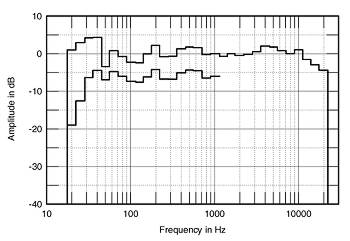| Columns Retired Columns & Blogs |
Revel Ultima Gem loudspeaker & Ultima Sub-15 subwoofer Measurements Page 4
Vertically (fig.10), the spaced woofers result in comb-filtering at extreme off-axis angles. The listener needs to listen to the Gem with his or her head between the centers of the woofers to get the designed balance from the Gem, hence the tall stands.
Footnote 2: For my in-room spectral analyses I average six measurements at each of 10 separate microphone positions for left and right speakers individually, giving a total of 120 original spectra. These are then averaged to give a curve that, in my room, has proved to give a good correlation with a loudspeaker's perceived balance. I use an Audio Control Industrial SA-3050A spectrum analyzer with its own microphone, which acts as a check on the MLSSA measurements made with the B&K mike.—JA

Fig.10 Revel Ultima Gem, vertical response family at 50", normalized to response on tweeter axis, from back to front: differences in response 45 degrees-5 degrees above HF axis; reference response; differences in response 5 degrees-45 degrees below HF axis.
Fig.11 shows the spatially averaged response (footnote 2) of the Gems and Sub-15 in my listening room, with the rear tweeter on and set to "0" and the front tweeter set as I preferred it, to "-0.5dB." The response trend is very flat, meeting ±1.5dB limits all the way from 160Hz to 10kHz. But you can see a slight excess of in-room energy in the octave above 3kHz, which might well correlate with the slight treble "bite" I occasionally noted in my auditioning. You can see that the Sub-15 does extend the response down to 20Hz, even with the boundary EQ switched into circuit. But note the lack of energy in the 50Hz third-octave band: I could not get a good balance in my room between this band and the ones to either side.
Note also the residual peak at 200Hz. After much experimentation with speaker position, I reduced this but could never entirely eliminate it, the result being a slight warmth to the system's sound. The lower trace in fig.11 is the in-room response of the Gems without the Sub-15, offset for clarity. You can see that the room integration in the upper bass is actually a little better than with the subwoofer, but also that the sub does add a considerable amount of energy in the midbass and below.

Fig.11 Revel Ultima Gem/Sub-15, 1/3-octave, spatially averaged response in JA's room. HF contour set to "-0.5," rear tweeter set to "0." Lower curve is the Gems without the subwoofer, offset by -6dB for clarity.
Footnote 2: For my in-room spectral analyses I average six measurements at each of 10 separate microphone positions for left and right speakers individually, giving a total of 120 original spectra. These are then averaged to give a curve that, in my room, has proved to give a good correlation with a loudspeaker's perceived balance. I use an Audio Control Industrial SA-3050A spectrum analyzer with its own microphone, which acts as a check on the MLSSA measurements made with the B&K mike.—JA
- Log in or register to post comments




































